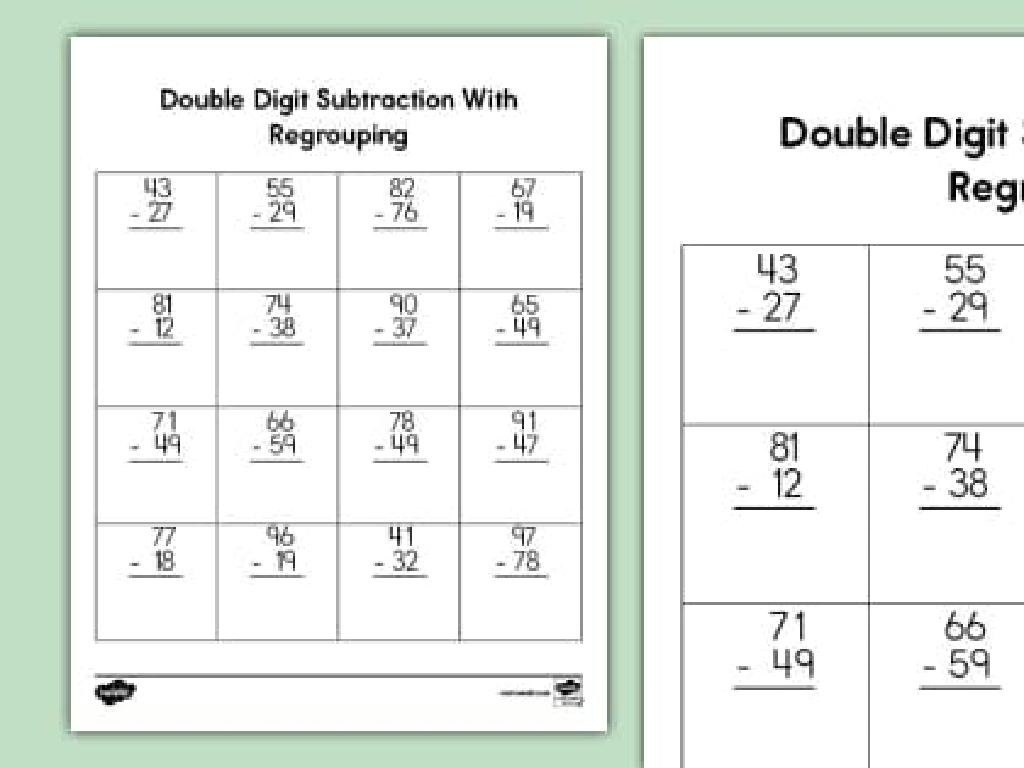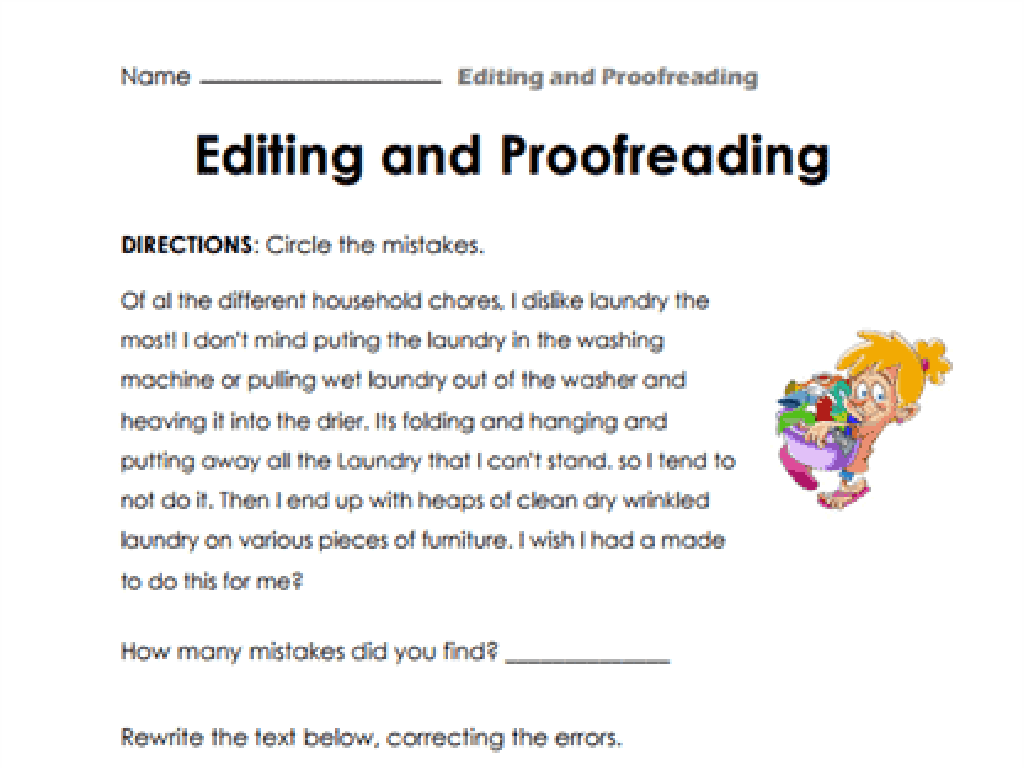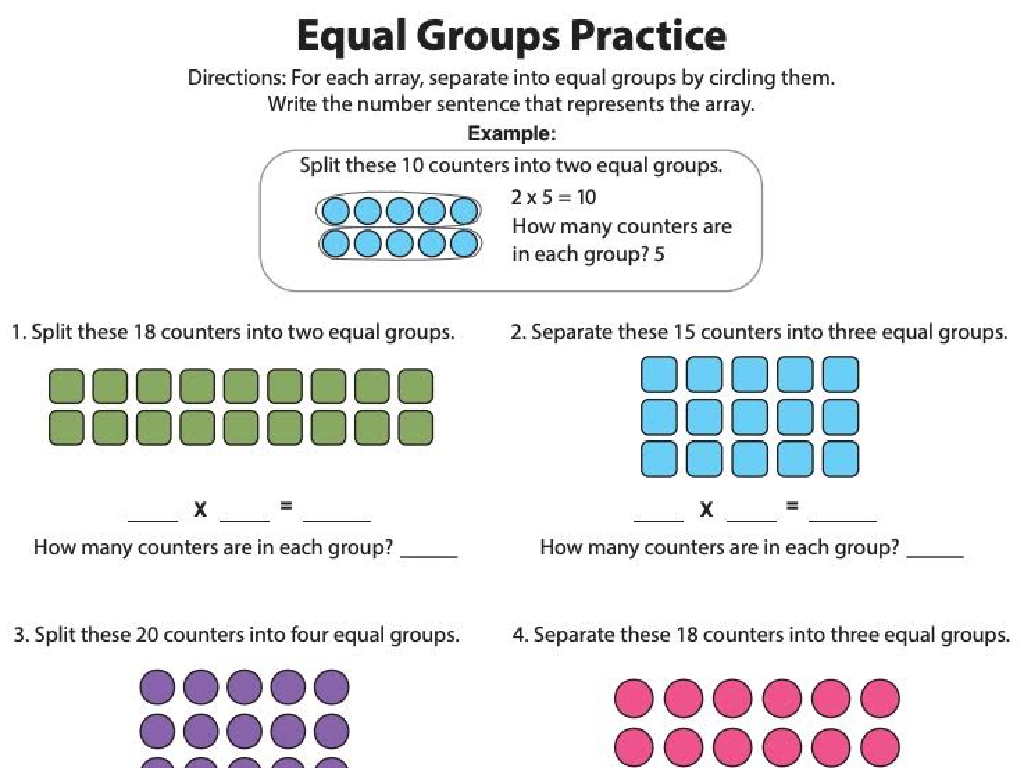Write Fractions In Lowest Terms
Subject: Math
Grade: Third grade
Topic: Equivalent Fractions
Please LOG IN to download the presentation. Access is available to registered users only.
View More Content
Today’s Adventure: Equivalent Fractions!
– Fractions represent parts of a whole
– Equivalent fractions are equal
– 1/2 is equal to 2/4 or 3/6. They all represent the same part of a whole.
– Simplify fractions to lowest terms
– To simplify, divide the top and bottom by the same number!
– Practice with examples
– Let’s try simplifying 3/9 or 4/8 together.
|
This slide introduces the concept of fractions as parts of a whole and explains that equivalent fractions, though they may look different, represent the same value. Emphasize the idea of simplifying fractions to their lowest terms by finding the greatest common divisor for the numerator and denominator. Provide clear examples and encourage students to practice simplifying fractions with hands-on activities. Use visual aids like pie charts or fraction bars to help students visualize the concept. The goal is to ensure students understand that fractions can be expressed in different forms but still be equal in value.
Understanding Fractions
– A fraction shows part of a whole
– Example: 1/2 of a pizza
– 1 out of 2 equal parts of a pizza
– Numerator: the top number
– Tells us how many parts we have
– Denominator: the bottom number
– Tells us into how many parts the whole is divided
|
This slide introduces the concept of fractions to third-grade students. Begin by explaining that a fraction represents a part of a whole, such as a piece of pizza. Use visual aids like a drawing of a pizza cut into equal parts to illustrate the concept. Clarify that the numerator, the top number of the fraction, indicates how many parts we’re talking about, while the denominator, the bottom number, shows the total number of equal parts the whole is divided into. Encourage students to think of other examples of fractions they encounter in everyday life, like a half hour (30 minutes) or a quarter of a dollar (25 cents).
Understanding Equivalent Fractions
– What are equivalent fractions?
– Fractions that have the same value, but look different
– Example: 1/2 equals 2/4 and 3/6
– 1/2 is the same as 2/4 or 3/6 because they all represent half
– Finding equivalent fractions
– Multiply or divide the numerator and denominator by the same number
– Simplifying fractions to lowest terms
– Divide both the top and bottom numbers by their greatest common divisor
|
Begin by explaining that equivalent fractions are different fractions that represent the same part of a whole. Use visual aids like pie charts or fraction bars to show that 1/2, 2/4, and 3/6 cover the same amount of space. Teach students how to find equivalent fractions by multiplying or dividing both the numerator (top number) and the denominator (bottom number) by the same non-zero number. Emphasize the concept of simplifying fractions by dividing both the numerator and denominator by their greatest common divisor (GCD) to get the fraction in its lowest terms. Provide practice problems for students to try simplifying fractions on their own.
Creating Equivalent Fractions
– Multiply top and bottom by the same number
– Example: 1/2 becomes 2/4 when multiplied by 2/2
– Starting with 1/2, we multiply both 1 (top) and 2 (bottom) by 2 to get 2/4
– Practice making fractions equivalent
– Let’s create equivalent fractions as a class activity
– Understand why they are equal
– Equivalent fractions represent the same part of a whole even if they look different
|
This slide introduces the concept of creating equivalent fractions by multiplying the numerator (top number) and the denominator (bottom number) by the same number. Use the example of multiplying 1/2 by 2/2 to get 2/4 to illustrate this concept. During the class activity, guide students to create their own examples of equivalent fractions. Explain that even though 1/2 and 2/4 look different, they represent the same amount. This is because we have simply multiplied by a form of one (2/2), which doesn’t change the value of the fraction. Encourage students to explore this concept with different numbers and to understand that this is a fundamental property of fractions.
Writing Fractions in Lowest Terms
– What are lowest terms?
– The simplest form of a fraction with no common factors
– How to simplify fractions
– Divide by greatest common factor
– Find the largest number that divides both the top and bottom numbers
– Example: Simplifying 4/8
– 4 divided by 4 is 1, and 8 divided by 4 is 2, so 4/8 becomes 1/2
|
This slide introduces the concept of reducing fractions to their simplest form, known as ‘lowest terms.’ Begin by explaining that a fraction is in lowest terms when the numerator (top number) and the denominator (bottom number) have no common factors other than 1. Teach students how to find the greatest common factor (GCF) of the numerator and denominator and use it to simplify fractions. Use the example of 4/8 to demonstrate the process: since 4 is the GCF of 4 and 8, dividing both by 4 simplifies the fraction to 1/2. Encourage students to practice with different fractions and check their work by ensuring the simplified fraction cannot be reduced further.
Practice Time: Reducing Fractions
– Let’s practice simplifying fractions
– We’ll solve examples as a class
– Find the greatest common factor (GCF)
– The largest number that divides both numerator and denominator
– Use the GCF to write fractions in lowest terms
– Divide both by the GCF to simplify the fraction
|
This slide is designed for an interactive class activity where students will engage in reducing fractions to their simplest form. Start by explaining the process of simplifying fractions, emphasizing the importance of finding the greatest common factor (GCF). Work through several examples together, guiding students to identify the GCF for each fraction. Once the GCF is found, show students how to divide both the numerator and the denominator by this number to simplify the fraction. Encourage students to participate and try simplifying fractions on their own, providing assistance as needed. Prepare different levels of examples to cater to varying student abilities, ensuring everyone can follow along and feel included in the activity.
Class Activity: Fraction Scavenger Hunt
– Find classroom objects
– Create equivalent fractions
– If an object is divided into 4 parts and 2 are used, the fraction is 2/4
– Reduce fractions to lowest terms
– Simplify 2/4 to 1/2 by dividing both numerator and denominator by 2
– Share your findings with the class
|
This interactive activity is designed to help students understand the concept of equivalent fractions and how to simplify them to their lowest terms. Students will search for objects in the classroom that can be divided into parts, such as a set of blocks or a paper divided into sections. They will then create fractions representing parts of the objects they find and work on reducing those fractions. For example, if a student finds a pizza cut into 8 slices and 4 are left, they create the fraction 4/8 and reduce it to 1/2. Provide guidance on how to find the greatest common divisor (GCD) and use it to simplify fractions. After the activity, students will share their objects, the equivalent fractions they created, and the simplified fractions with the class. This will reinforce their understanding and allow for peer learning. Prepare 4-5 different activities for variation among students, such as finding fractions of a group of pencils, parts of a book, or sections of a window.
Homework: Fractions in Lowest Terms
– Congratulations on learning equivalent fractions!
– Homework: Find 5 objects at home
– Look for items like a pack of crayons or a pizza
– Write fractions for objects in lowest terms
– Simplify the fractions of parts you found
– Share your fractions in class tomorrow
|
Today’s lesson on equivalent fractions was a success, and now it’s time for students to apply what they’ve learned. For homework, they are tasked with finding everyday objects that can be divided into parts, like a half-eaten pizza or a pack of crayons with some missing. They should write down the fraction that represents the part of the whole and then simplify it to its lowest terms. This exercise will help reinforce their understanding of fractions and the concept of simplification. Tomorrow, we will have a sharing session where each student will present their objects and the fractions they’ve calculated. This will not only help them articulate their understanding but also allow them to see practical applications of fractions in their daily lives.





